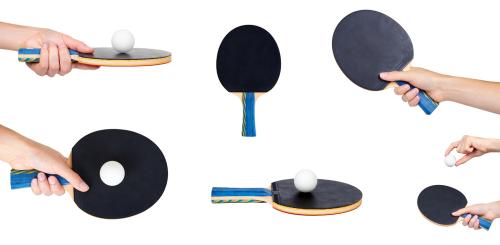HOW TO GRIP A PING PONG PADDLE! SO EASY

Ping pong is an amazing sport that requires an outstanding hand-eye coordination and quick reflexes. Playing ping pong as a professional involves understanding the basic skills of the game such as being able to hit the ball on the other side of the net and being able to serve the ball to the opponent.
This guide will teach beginners how to hold a ping pong
paddle properly. Holding the paddle properly is very important in the learning
process because getting used to a different grip may become more difficult as
the player becomes more skilled to the sport. This is why it is better to start
with the proper grip.
There are two main types of grip: the Shake-hands grip and
the Pen-holder grip.
There are some variations applicable to each of these types
of grip and there are also less commonly used grips such as: Seemiller grip,
V-grip, Pistol grip.
Although these grips are not commonly used especially at
tournaments, it is not known if this is due to their inferiority or because
they appear new to the ping pong game.
For this reason, it is recommended that beginners start with
the shake-hand grip or the pen-holder grip, since it will be easier to get
expert advice and coaching for these grip styles. The number of competent
coaches of Seemiller, V-grip or Pistol grip type players would be very few at
the moment due to the unpopular nature of these grip types.
Shake-hands Grip
As the name implies, the handle is gripped the same way a
hand is gripped while shaking hands. It is the most commonly used ping pong
grip and a great start for beginners.
The thumb and other fingers except the index finger are
wrapped around the handle and gripped firmly while the index finger is placed
close to the base of the paddle. By so doing, the handle is gripped firmly.
With the shake-hands grip, backhand are being performed with
ease but it has a disadvantage of a wide crossover point between backhand and
forehand. This means that, by using the shake-hands grip, there is an area
where a player cannot easily hit with backhand or forehand without changing
position.
Although there are several minor variations of this grip
type, the two main versions of this grip are the Shake-hand Shallow Grip and
the Shake-hand Deep Grip.
Pen-hold Grip
The Pen-hold grip as the name implies is similar to holding
a pen. The thumb and index finger is wrapped around the handle close to the
beginning of the handle while other fingers are laid out across the back of the
paddle to grip it firmly while making sure that the fingers doesn’t obstruct
the use of backhand.
This grip is not as popular as the shake-hands grip and
majority of its users are Asian. This grip type gives the advantage of covering
a wide area with forehand and backhand without changing position but it is
difficult to perform backhand with it.
Backhand’s performed with a Pen-hold grip doesn’t have much
impact compared to backhand with a Shake-hand grip even when mastered and it is
also very hard to master.
The Traditional Chinese Grip, Japanese/Korean Grip, Reverse
Pen-hold Backhand Chinese Grip are its main versions.
Minor Grip
Seemiller Grip
In the Seemiller grip, the paddle is held with a 90-degree
turn and similar to the Shake-hand grip but the thumb and index finger are used
to hold the sides of the racket.
The backhand and forehand are played with the same side of
the paddle, although the racket can be turned to use the other side. This grip
type is typically used with a combination bat.
The Seemiller grip allows the movement of the wrist when
performing a forehand stroke with a powerful forehand topspin. It is excellent
for blocking on both sides. Also, there is no problem of a crossover point
because one side of the racket can be used for both forehand and backhand.
The problem about this grip type is that, the ability to hit
the ball with great power is limited because on the backhand side, the amount
of wrist movement is hampered.
This grip is commonly used by players with attacking style
who prefer to play with a steady backhand and a strong forehand topspin. In
recent years, the Seemiller grip is not commonly used at the highest levels of
the game.
If you are interested, you can visit here to know more about ping pong/ table tennis ( skills, equipment, practice...)
Post Your Ad Here
Comments